Comparing Media Rooms and Home Theaters | Find the Right Fit for Your Home
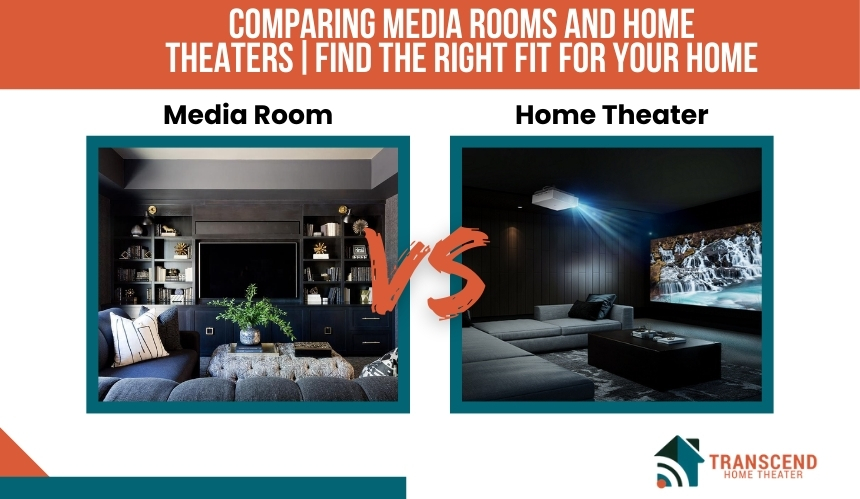
When homeowners think about elevating their entertainment space, two ideas often come up: designing a multipurpose media room or investing in a dedicated home theater. Both offer unique advantages, but they serve different needs. The choice often depends on how you enjoy movies, gaming, streaming, or family time.
A Quick Answer: If you’re looking for a flexible, multi-purpose space that fits seamlessly into your home, a media room is likely the right choice. However, if you want an immersive, cinematic experience and have the space for a dedicated room, a home theater provides unmatched performance. |
This guide explores both setups from different angles, including their design, cost, and lifestyle fit. This will help you make a well-informed decision that aligns with your goals, budget, and space requirements.
What Is a Multipurpose Media Room?

A multipurpose media room is a versatile space designed to accommodate various activities, typically blending entertainment and everyday living. Instead of being dedicated to movies alone, it can transform into a casual lounge, gaming zone, or social hangout.
Technology in a media room is balanced: a large television, retractable projector, and streaming devices provide convenience without requiring permanent, theater-style construction. This makes it popular in households where one room needs to serve multiple functions.
What Is a Dedicated Home Theater?
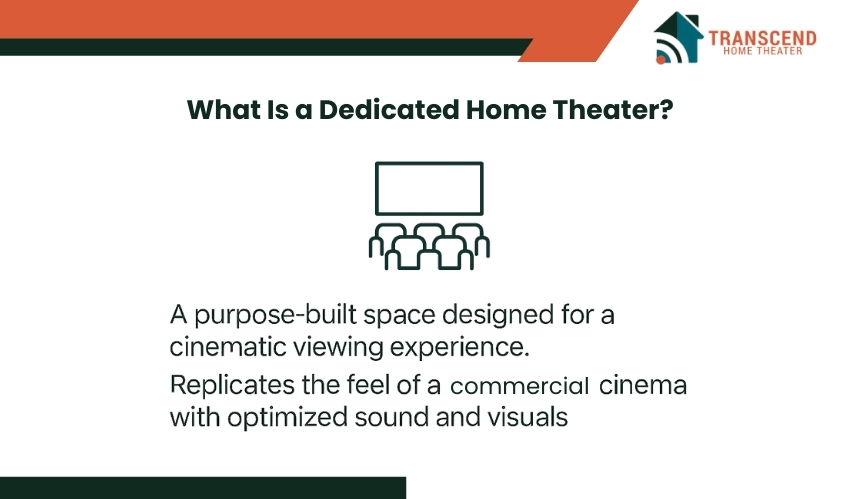
A dedicated home theater is a purpose-built space designed exclusively for cinematic viewing. Unlike a multipurpose media room, it is designed for a complete immersion experience. The setup of a home theater replicates the feel of a commercial cinema, from seating arrangement to sound system calibration.
A dedicated theater offers a premium experience that transforms film watching into an event. It is an ideal choice for homeowners who value authenticity in movies and audio quality.
What are the Key Technical Differences Between a Multipurpose Media Room and a Dedicated Home Theater
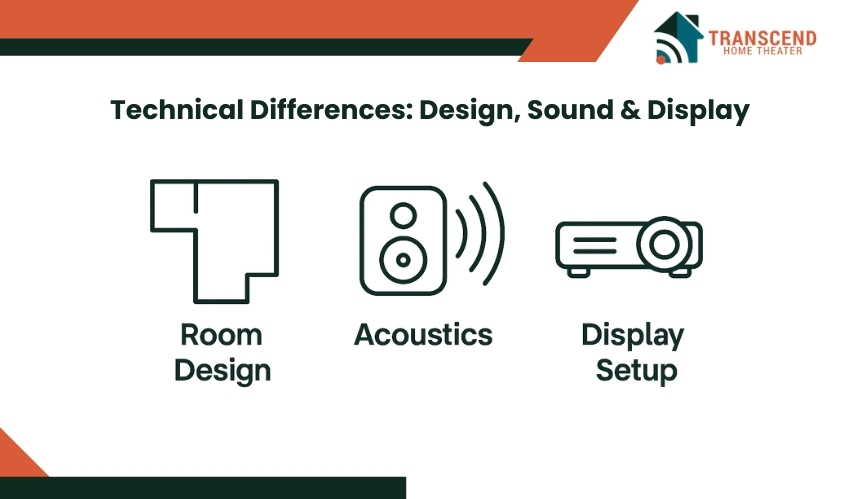
Beyond lifestyle and personal preferences, the biggest contrasts between a media room and a home theater come down to technical setup and construction. Let’s explore how each space performs, what equipment is required, and how future upgrades can be handled.
Room Design and Architecture
A media room is usually part of an existing living area or basement. It works within the home’s current layout, with minimal changes to walls, flooring, or ceiling. Dedicated construction is rarely needed, making it easier to integrate with everyday spaces.
A home theater, however, requires an enclosed room with controlled proportions. The architecture often includes sound-isolated walls, acoustic panels, and raised platforms for seating. These structural elements are engineered to improve sound distribution and viewing angles.
Acoustics and Sound Management
In a media room, audio is shared with the rest of the home. Open layouts, windows, and hard surfaces can cause sound reflections, which means the experience depends heavily on the equipment rather than the room itself. Basic soundbars or surround-sound speakers are common.
In contrast, a home theater is acoustically engineered. The space may include insulation, bass traps, and wall treatments to eliminate echoes and external noise. This allows high-end surround systems to perform at their best, delivering cinema-grade sound clarity and depth.
Display and Projection Setup
Media rooms typically rely on large-screen televisions or retractable projectors. The setup is flexible, balancing size with practicality. Screens may share wall space with artwork or shelving, emphasizing versatility.
Home theaters are designed around projection systems or fixed large-format screens. Screen size is calculated in relation to room dimensions and seating distance, ensuring an authentic theater-like scale. Projectors are paired with calibrated brightness and contrast to optimize image quality in a darkened room.
Lighting Control
Lighting in a media room is multipurpose, just like the space itself. Natural light is often present, with lamps or recessed lighting supporting everyday activities. Blackout control is optional, not a necessity.
Home theaters prioritize light control. Blackout curtains, dimmable sconces, and hidden LED strips are used to eliminate glare and maintain focus on the screen. The lighting design contributes as much to the immersive feel as the sound or display system.
Wiring and Technology Integration
A media room usually relies on straightforward wiring and wireless solutions. Equipment is often plug-and-play, with components like gaming consoles, streaming devices, and speakers connecting through visible or semi-concealed cabling.
Home theaters feature fully integrated wiring systems. AV receivers, amplifiers, and in-wall or in-ceiling speakers are carefully concealed during construction. This creates a seamless, professional-grade setup that is difficult to replicate in a flexible, shared room.
Scalability and Upgrades
Upgrading a media room is simple, since homeowners can swap out devices or add components as needed. The design is not fixed, making it easier to keep pace with evolving technology.
A home theater is less flexible but more future-proof in performance. Once built, its specialized wiring and acoustic treatments provide a foundation for long-term use. Upgrades usually involve replacing high-end projectors, speakers, or processors rather than rearranging the room itself.
Choosing Between a Media Room and a Home Theater Based on Lifestyle Needs
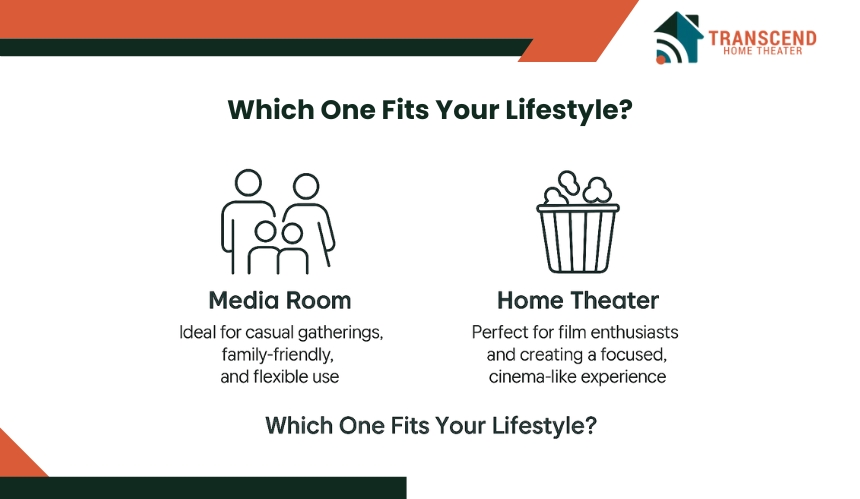
The right choice often depends less on technology and more on how you actually live and enjoy entertainment. Let’s explore which option better fits your lifestyle.
When a Media Room Fits Your Lifestyle
A media room is the right fit if you want one space to do more than just play movies. Families often prefer it because it doubles as a hangout zone where kids can game, parents can relax, and guests can enjoy sports nights.
For households where entertainment is woven into daily routines, the media room shines. It doesn’t require a special setup every time you want to use it. If you value togetherness, flexibility, and the ability to switch activities without leaving the room, a multipurpose media room delivers that balance seamlessly.
When a Dedicated Home Theater Fits Your Lifestyle
A home theater becomes a better option when entertainment becomes a passion, not just a side activity. Movie enthusiasts who crave cinematic immersion will appreciate the controlled environment that blocks out distractions and maximizes sound and picture quality.
It also suits homeowners who enjoy hosting planned viewing events, where the focus is entirely on the film or concert experience. If you want entertainment to feel like an occasion rather than an everyday background activity, a dedicated theater is best for you.
How Much Space Do You Need for a Media Room vs. a Home Theater?
Square footage is a practical factor that can quickly guide the decision. A media room does not require a dedicated footprint; it can work well within 250 to 350 square feet of open living space, such as a family room or basement.
A home theater, on the other hand, benefits from a dedicated enclosed room, usually starting at around 300 to 400 square feet for a compact setup. Larger, luxury theaters may extend to 500 square feet or more to accommodate tiered seating, wider screens, and acoustic treatments.
That said, a dedicated home theater is not limited only to large properties. With smart design and professional home theater installation, even small or mid-sized homes can integrate a compact theater without sacrificing comfort or performance.
Cost and Budget Considerations for a Media Room vs. a Home Theater
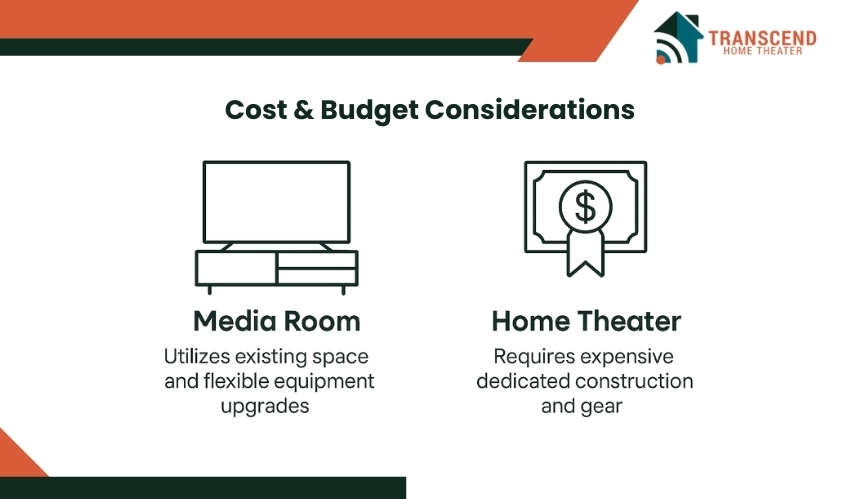
The financial investment for a media room and a home theater is very different. Understanding where the money goes in each setup will help you decide which one fits your budget and long-term goals.
What Are the Typical Costs of a Media Room?
A multipurpose media room is typically the more budget-friendly option. Since it often uses an existing living area or basement, major construction costs are avoided. Many homeowners start with a large television, a soundbar or entry-level surround system, and comfortable seating.
As needs grow, upgrades like a retractable projector, enhanced speakers, or better lighting can be added in phases. The flexibility in cost makes a media room attractive to families who want entertainment without committing to a large upfront investment.
Depending on size, furniture, and equipment, a media room can range from modest upgrades of a few thousand dollars to more advanced setups that climb into the mid-five figures.
What Are the Typical Costs of a Home Theater?
A dedicated home theater requires a much larger upfront budget because it involves specialized construction and premium equipment. Expenses typically include soundproofing materials, acoustic treatments, projector and screen installation, tiered seating, advanced surround-sound systems, and professional calibration.
While a small-scale home theater may start in the tens of thousands, fully equipped theaters with luxury finishes can run significantly higher. Unlike a media room, the expenses are not usually phased. Most of the investment happens before the theater is usable.
For homeowners who view a theater as a long-term luxury feature, the financial commitment is balanced by the exclusivity of the experience.
Final Thoughts on Media Rooms and Home Theaters
A media room remains the more adaptable option, evolving with new technologies and changing household needs. A home theater, by contrast, secures its place as a purpose-driven investment that delivers lasting cinematic quality.
The better choice is not about which is universally superior, but which aligns with the priorities of the home and the expectations of long-term value.
For homeowners seeking expert design and seamless installation, Transcend Home Theater specializes in creating custom theaters that bring professional-grade entertainment into any home. Reach out today to turn a vision of the perfect theater into reality.
Frequently Asked Questions (FAQs)
Do media rooms and home theaters require different maintenance?
Yes. Media rooms typically need minimal maintenance since most equipment is standard consumer-grade electronics. Home theaters may require periodic calibration of audio systems, projector bulb replacements, and upkeep of specialized finishes to preserve performance.
Can a media room be converted into a home theater later?
Yes, a media room can be converted into a home theater, but the process usually involves significant remodeling. Adding soundproofing, acoustic treatments, and specialized wiring are necessary steps to transform an open media room into a fully dedicated theater.
Do media rooms or home theaters impact energy use differently?
Generally, media rooms consume less energy since they rely on everyday lighting and television displays. Home theaters often use projectors, amplifiers, and advanced sound systems. This can increase electricity usage during operation.
What role does furniture selection play in each setup?
In a media room, furniture is chosen for versatility, often serving both entertainment and daily living needs. In a home theater, seating is specialized, designed for long viewing sessions, and often arranged in tiers for optimal sightlines.
Are there noise concerns with a media room vs. a home theater?
Yes. Because media rooms are open to other areas of the home, sound can travel easily and cause disturbances. Home theaters are built with isolation in mind, keeping audio contained and minimizing outside noise interference.
